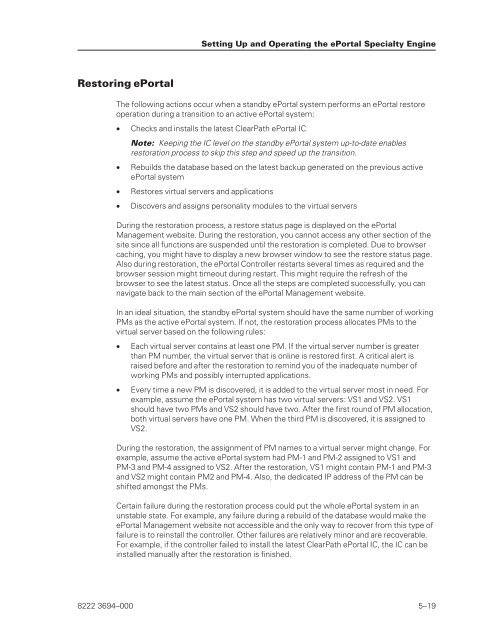FS6200 Server System Implementation Guide - Public Support ...
FS6200 Server System Implementation Guide - Public Support ...
FS6200 Server System Implementation Guide - Public Support ...
Create successful ePaper yourself
Turn your PDF publications into a flip-book with our unique Google optimized e-Paper software.
Restoring ePortal<br />
The following actions occur when a standby ePortal system performs an ePortal restore<br />
operation during a transition to an active ePortal system:<br />
• Checks and installs the latest ClearPath ePortal IC<br />
Note: Keeping the IC level on the standby ePortal system up-to-date enables<br />
restoration process to skip this step and speed up the transition.<br />
• Rebuilds the database based on the latest backup generated on the previous active<br />
ePortal system<br />
• Restores virtual servers and applications<br />
Setting Up and Operating the ePortal Specialty Engine<br />
• Discovers and assigns personality modules to the virtual servers<br />
During the restoration process, a restore status page is displayed on the ePortal<br />
Management website. During the restoration, you cannot access any other section of the<br />
site since all functions are suspended until the restoration is completed. Due to browser<br />
caching, you might have to display a new browser window to see the restore status page.<br />
Also during restoration, the ePortal Controller restarts several times as required and the<br />
browser session might timeout during restart. This might require the refresh of the<br />
browser to see the latest status. Once all the steps are completed successfully, you can<br />
navigate back to the main section of the ePortal Management website.<br />
In an ideal situation, the standby ePortal system should have the same number of working<br />
PMs as the active ePortal system. If not, the restoration process allocates PMs to the<br />
virtual server based on the following rules:<br />
• Each virtual server contains at least one PM. If the virtual server number is greater<br />
than PM number, the virtual server that is online is restored first. A critical alert is<br />
raised before and after the restoration to remind you of the inadequate number of<br />
working PMs and possibly interrupted applications.<br />
• Every time a new PM is discovered, it is added to the virtual server most in need. For<br />
example, assume the ePortal system has two virtual servers: VS1 and VS2. VS1<br />
should have two PMs and VS2 should have two. After the first round of PM allocation,<br />
both virtual servers have one PM. When the third PM is discovered, it is assigned to<br />
VS2.<br />
During the restoration, the assignment of PM names to a virtual server might change. For<br />
example, assume the active ePortal system had PM-1 and PM-2 assigned to VS1 and<br />
PM-3 and PM-4 assigned to VS2. After the restoration, VS1 might contain PM-1 and PM-3<br />
and VS2 might contain PM2 and PM-4. Also, the dedicated IP address of the PM can be<br />
shifted amongst the PMs.<br />
Certain failure during the restoration process could put the whole ePortal system in an<br />
unstable state. For example, any failure during a rebuild of the database would make the<br />
ePortal Management website not accessible and the only way to recover from this type of<br />
failure is to reinstall the controller. Other failures are relatively minor and are recoverable.<br />
For example, if the controller failed to install the latest ClearPath ePortal IC, the IC can be<br />
installed manually after the restoration is finished.<br />
8222 3694–000 5–19
















